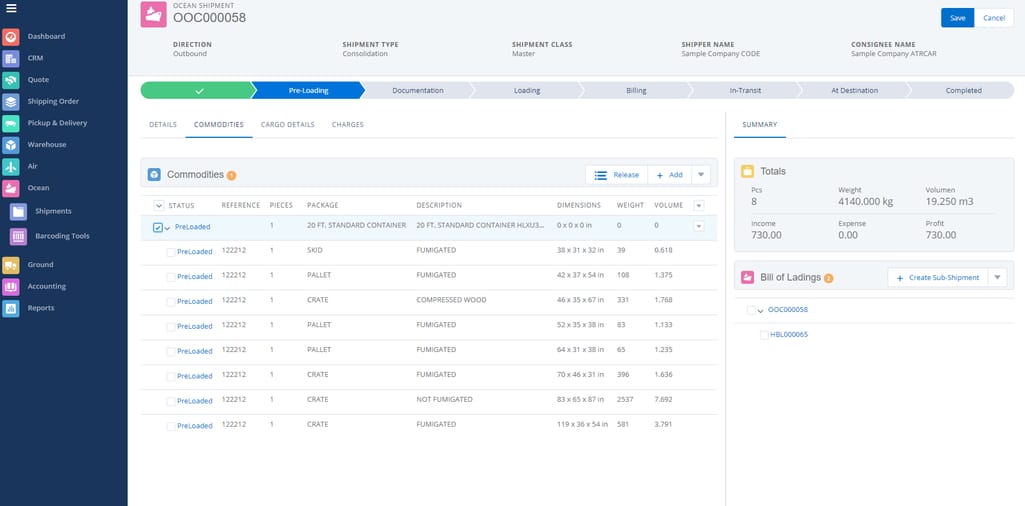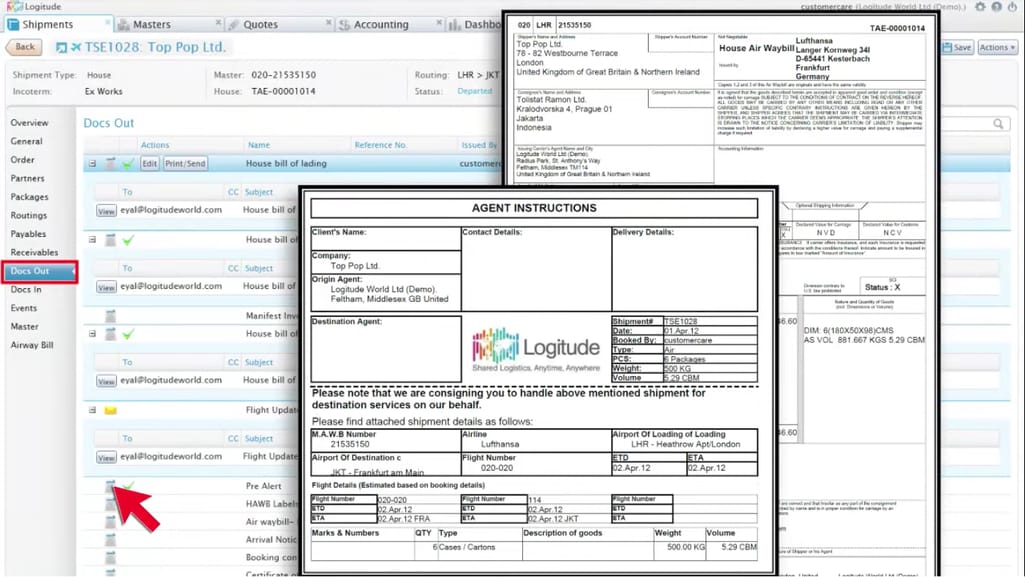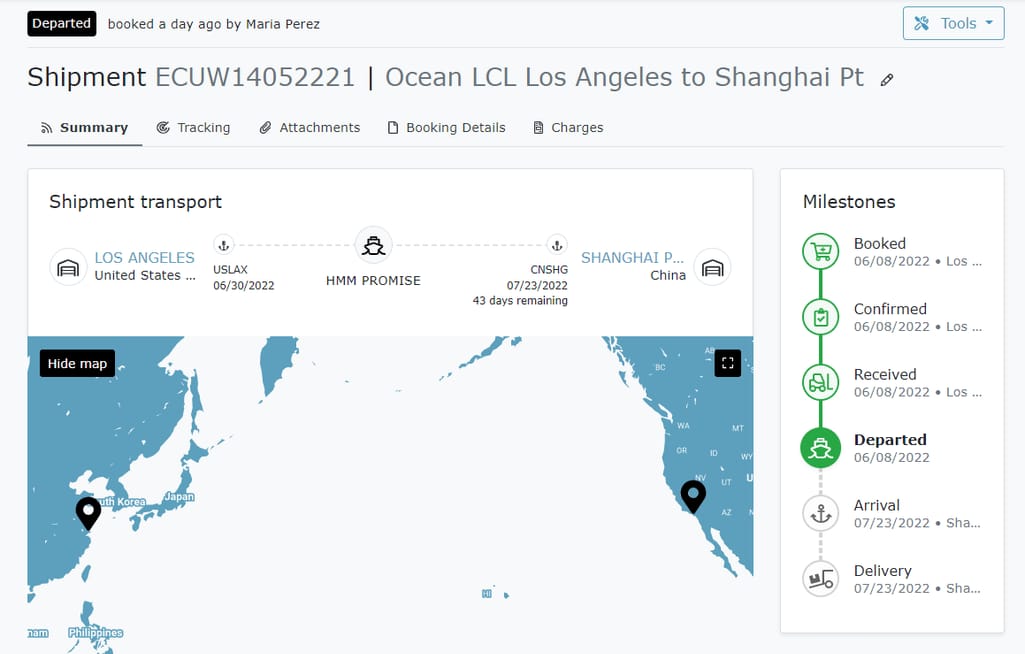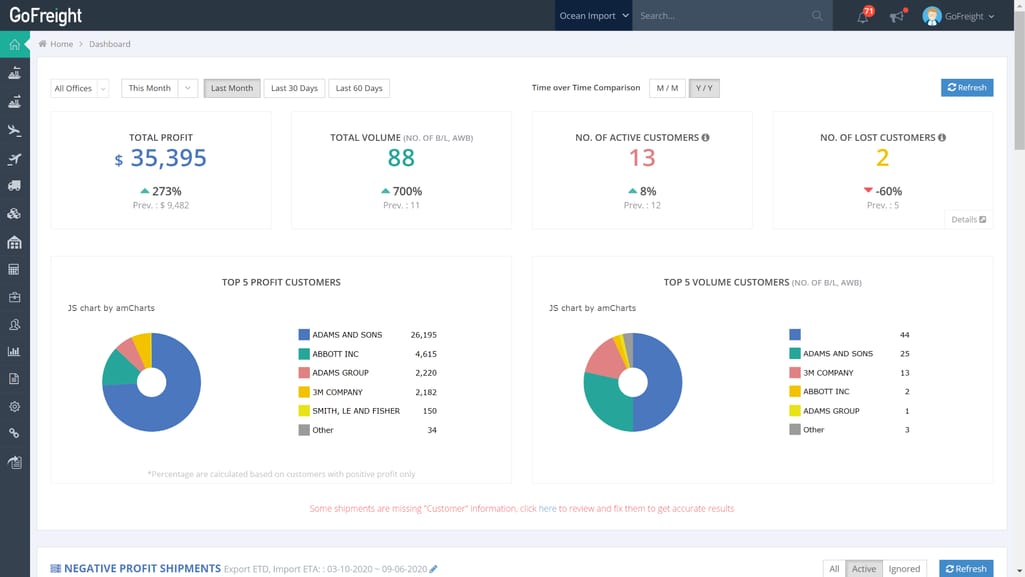Freight forwarders are experts that boost global trade and international transportation. In 2021, according to different studies, the freight forwarding market was valued at $186 to $192.5 billion. So in this post, we look at the freight forwarder role in the global supply chain and discuss how technology can support their operations.
What is a freight forwarder?
Freight forwarders are intermediaries between shippers (manufacturers, wholesalers, or retailers) and carriers (sea, air, and land transportation providers) that organize and coordinate the movement of goods across international borders.
So freight forwarders don’t actually ship freight, but they serve as experts that arrange one or several transportation modes and can sometimes provide other logistics services including
- inland transportation from origin and/or to destination,
- goods storage,
- preparation of customs and other shipping documentation,
- freight consolidation and deconsolidation,
- container tracking,
- insurance services,
- import customs clearance, and so on.
Shippers can definitely arrange transportation of their goods themselves and save on the commission, but it often turns out that outsourcing it to professional freight forwarders pays off in the long run. That’s because their expertise and established relationships with carriers allow them to move freight in the cheapest, fastest, and most reliable way.
Before we get to describing the typical freight forwarding process, let’s clear up a few more terms.
Freight forwarders vs 3PLs vs NVOCCc vs freight brokers vs customs agents
Freight forwarder vs 3PL
The line between them is very blurry as these two roles perform similar functions. However, freight forwarders primarily focus on the transportation aspects, plus handle documentation, customs clearance, and load consolidation. 3PL companies often manage the entire supply chain, and offer full-service fulfillment including storage, packing, kitting, last-mile delivery, reverse logistics, and so on.
Freight forwarder vs NVOCC
Both Non-Vessel Operating Common Carriers (NVOCCs) and freight forwarders can help exporters ship their freight. But NVOCCs perform the functions of ocean carriers, booking space on vessels and issuing their own bill of lading (BOL), while freight forwarders deal with all transportation modes, provide a much wider range of services (e.g., storage, documentation, packing, inland haulage), and typically act on behalf of shippers.
So in terms of relationships, we can say that NVOCCs are carriers for shippers, while forwarders are agents for shippers.
Freight forwarder vs freight broker
Freight brokers usually organize regional, inland transportation and only connect the shipper and the carrier, never getting hold of the freight itself (i.e., not taking responsibility for moved goods), while freight forwarders deal with international loads and often directly handle shipments (as they provide storage, packing, pickup/delivery, and other logistics services).
Freight forwarder vs customs agent
Customs brokers help clear goods through customs – usually in the country of import. They don’t organize the transportation of goods, but only handle documentation and pay applicable duties, taxes, and other fees for imported merchandise on behalf of the importer. A freight forwarder provides more services, often including customs brokerage.
Freight forwarding process and key documentation involved
Obviously, there are different scenarios of interactions with freight forwarders and organizing international transportation. But we’ll look at one of the common situations and list the most important documentation involved.
Let’s imagine there’s Jack who produces clothing somewhere in Turkey and wants to sell it to a US retailer. There’s also Sam who is an experienced freight forwarder working in a big company that offers a wide range of services. So that’s how it happens.
Freight forwarding process
Application, quotation, and contract signing. As we’ve mentioned, typically, it’s the shipper who hires the freight forwarder to arrange transportation and ensure goods are delivered safely (if that's their responsibility within the selected Incoterms rule). To initiate cooperation, Jack sends Sam a request for a quotation (RFQ) that lists all the required services. Sam replies with a quote and after settling all the details, the parties sign the contract of carriage.
Documents: RFQ, quote, contract
Cargo pickup. Sam organizes the pickup from Jack's facility (factory, warehouse, etc.) and hauls goods to his own storage location for further handling. Jack must provide all the related documents of the goods needed for customs clearance and international transportation.
When goods are being picked, Sam issues a house BOL as evidence of goods receival and hands it to Jack. A BOL is a legally binding document and the most important piece of paperwork in international trade which serves as a proof of ownership.
Documents: house BOL
Storage and consolidation. Sam keeps goods at his warehouse (luckily, Jack’s clothing doesn’t require any special storage conditions like some temperature-sensitive products do) and waits for more loads to consolidate them. He knows that combining multiple less-than-container loads from different shippers into one full-container load can significantly cut shipping costs.
Transporting goods to the port. Depending on the mode of transportation he has arranged, Sam organizes inland haulage of goods to the marine port, airport, or rail terminal. Usually, it’s done before customs clearance, but not necessarily.
Export customs clearance. When it’s time to ship the goods, Sam (being an authorized customs broker too) prepares and submits the export documentation. He knows all the requirements, rules, and regulations of various countries and makes sure that nothing gets overlooked and that all customs procedures are handled correctly. He also consults Jack on export taxes and duties or pays them on his behalf.
Documents: export declaration, export permit, proforma/commercial invoice, packing list, proof of origin, insurance certificate, etc.
Handing over to the carrier. After the goods are cleared, they can be handed over to the carrier. Depending on the transportation mode, the carrier issues a master BOL which can be an air waybill (AWB), marine BOL, or rail waybill. Sam collects the BOL and sends its originals to Jack and the receiver.
Documents: master BOL
Tracking shipment en route. Sam knows how important it is for Jack to know where the goods are, so he regularly keeps him posted with updates on the shipment location and ETA.
Import customs clearance. When the goods arrive in the country of destination, they have to be cleared again, so Sam hires the local customs broker to perform all the required clearance procedures.
Documents: proforma/commercial invoice, proof of origin, master BOL, customs value declaration, insurance certificate, etc.
Inland haulage to the receiver. Once customs releases the goods, Sam organizes inland haulage (by rail or truck) to the point of destination. The receiver presents his copy of the BOL to prove the right to claim the shipment.
Documents: master BOL
As you can see, the freight forwarding business isn’t a cakewalk. There’s a lot of hustle and bustle involved in the process itself, not to mention the inevitable disruptions that always happen in supply chains and require immediate reaction. So today, specialized software that helps automate most of the freight forwarding workflows is a real lifesaver. Let’s see how it can help.
Freight forwarding software and its key features
Digital technology can’t ship freight or pack goods into a container. However, software solutions can streamline most of the freight forwarder’s daily operations facilitating the entire process – from quotation to invoicing. Its most valuable benefits are
- document generation,
- ease of data exchange and communication with shippers and carriers, and
- having all information in one system so that you get the fullest picture of your activities.
Typically, such platforms include several key modules that cover logistics operations, customer relationships, and accounting. But we’ll look a bit deeper and discuss the most important and sought after features.
Rate quote generation
The freight forwarding business isn’t a coffee shop with clear, set prices. The rate quote depends on a lot of factors such as the type of commodity, amount of goods to be shipped, preferred carrier and country of destination, and most importantly, the range of services required.
Calculating quotes for each separate case can take forever if done manually, but software automates this process and helps you generate a quote once you know all the customer requirements.
You can set up custom business rules with your company’s charges, tariffs, and markups. Besides, modern platforms integrate with multiple carriers to have their current rates. So, when you get a request, you can quickly generate a quote for any transportation mode (or multimodal shipping) and see a detailed charge breakdown.
Order management
Once the shipper agrees with your quote, the fulfillment process starts, creating an order from the accepted quote. Via freight forwarding software dashboards, it’s convenient to monitor the status of all shipment orders, create recurring orders, detect errors, and so on. You can also set up notifications for important status updates.
Order management in Linbis
Another advantage of comprehensive platforms is efficient data exchange so that order details are easily shared with other modules (warehousing, invoicing, reporting, etc.).
Warehouse management
Not all freight forwarders offer storage and related services, but those who do would definitely benefit from the warehouse management (WMS) module. It helps plan and optimize storage space, track inventory, control picking and packing activities, coordinate staff, and get greater visibility into all warehousing aspects.
Load planning and consolidation
If you focus on consolidating partial shipments, this part is for you. Booking space for a container and sending it half-empty is not efficient, so a load planning or consolidation module can help you manage LCL shipments and combine them for utmost profitability. Having all the freight details in your system, you can create loading plans, compare costs, generate loading instructions, and so on.
Documentation management
Freight forwarding involves dealing with tons of documents. One of the main features of freight forwarding software is the capability to automatically generate BOLs, AWBs, customs documents, and so on. Not only does it save time, it also reduces errors and the need for paper record keeping.
Creating documents in Logitude
Storing documents is yet another issue. If you have heaps of printed quotes, sales orders, BOLs, warehouse documents, invoices, and other paperwork on your desk, you’re unlikely to perform well. The software allows you to keep it all organized, so that you can easily find, retrieve, monitor, and share important documentation associated with all your shipments. With digital document exchange functionality, you can quickly transfer contracts and other documents in multiple formats.
Shipment tracking
Tracking is one of the most crucial parts of the transportation process since all the parties involved always want to know where the shipment is. Today, due to the Internet of Things (IoT) and telematics technologies, carriers can provide real-time tracking information and ETA forecasts.
To have access to this information, most freight forwarding software platforms are integrated with the main transportation services providers. Once tracking data is collected, freight forwarders have several options of keeping their customers posted:
- send regular updates (manual or automated) via email or text,
- give access to data via a set of APIs if shippers want to monitor delivery status through their own system, or
- enable self-tracking through the website or customer portal.
Customer portal
Since ATMs were invented in the 1960s, the popularity of self-service is only growing. Freight forwarding isn’t an exception. Shippers want to be in control of the process and easily get answers to their questions, so it’s worth offering them a customer portal where they can request a quote, download documentation, track their shipment, consult a help desk, or even pay for your services via an integrated payment gateway.
Magaya web portal
Customs and regulatory compliance
Businesses that ship internationally have to comply with multiple regulations of different countries. Software can help you manage those compliance requirements by automating the filing process, electronically submitting customs documentation, performing denied party screening across multiple lists, notifying you about regulatory updates, etc.
CRM
Freight forwarding is a service business, so it’s vital to manage customer relationships properly to enhance loyalty and drive sales. A well-built CRM not only stores all the customer-related details but also helps you to analyze and score leads, manage sales, conduct and monitor marketing activities, and automate your communication with current, past, and potential clients. Some of the specific features include
- automated email replies and notifications,
- dashboards with leads status,
- automated follow-up activities,
- interaction logs and order/shipment history,
- sales KPI reporting, and more.

GoFreight reporting dashboard
Invoicing
Financial aspects demand accuracy and an invoicing module helps efficiently handle all accounting operations. You can automatically generate invoices, send them to your customers, and track their status. You can also manage incoming bills from your partners such as carriers, customs, brokers, and so on.
Since freight forwarders deal with international customers and partners, they need to handle multi-currency invoices and payments and the software helps them handle such transactions.
Reporting and analytics
Analytics is an essential factor of business growth and development. You can’t know how well you’re performing and what your opportunities for improvement are if you don’t collect and analyze data, so a reporting and analytics module will give you a bird’s-eye view of your company’s operations. Moreover, it’s vital to observe existing trends to be able to make forecasts and plan on future activities.
External integrations
We’ve already mentioned the importance of integrations. In addition to incorporating freight forwarding software into the internal IT ecosystem, it has to be connected to air, ocean, and land carriers (via either API or EDI) to view their availability and rates, book space, generate and send documentation, monitor shipment status, and more.
Now that you know what to look for in freight forwarding software, let’s sneak a peek at the market and see what it can offer.
Freight forwarding software providers
There are many logistics management systems and transportation management systems that can work for freight forwarders, but we’ll focus on the most specialized solutions that have gained popularity and industry recognition.
Freight forwarding software providers compared
Magaya: a robust product that covers all the main workflows
The Magaya Digital Freight Platform is actually a suite of products that includes
- Magaya Supply Chain that covers logistics and warehousing workflows,
- Magaya Digital Freight Portal that gives your customers control and visibility over their shipments,
- Magaya Rate Management that helps search for rates, manage margins, and create share quotes,
- Magaya Customs Compliance that streamlines compliance workflows, and
- Magaya CRM that’s designed for customer and sales process management.
The platform also has a number of extensions which are basically a bunch of integration options to connect to carriers, customs, tracking solutions, accounting tools, and other external systems.
Language. Magaya is available in English, Spanish, and Portuguese.
Price. Pricing starts from $210/user/month. For an exact quote, you have to contact the provider directly.
User reviews. Magaya users like the ease of operation, system performance, and having all the functionality in one system, as well as the robust capabilities of every separate module.
Descartes: multiple logistics tools with a focus on self-services and data
Descartes offers multiple logistics solutions for different needs – including the Broker & Forwarder Enterprise Systems. The platform streamlines shipment management, customs compliance, accounting, and customer relationship management.
Descartes also puts a big focus on enhancing customer self-service, so you can take advantage of a multifunctional branded portal enabling your clients quote, book, and track shipments.
Descartes is the provider that understands the value of data, so it offers a powerful business intelligence solution and a lead generation tool. Plus, there’s a global trade data library and trade content solutions to enhance such external platforms as Oracle Global Trade Management and SAP Global Trade Services.
Enterprise logistics businesses can benefit from other Descartes products that can be seamlessly integrated, e.g., a TMS, a routing tool, or B2B connectivity solutions.
Language. Descartes solutions are available in 11 languages.
Price. The basic cost of a license starts from $290 per user/month. For exact rate estimation, contact the provider directly.
User reviews. Users appreciate the tracking capabilities, as well as the customs and reporting modules. Also, the fixed pricing system is convenient and benefits growing businesses. However, there are some complaints about slow customer support and system performance after updates.
Logitude: comprehensive solution for small and mid-size businesses
Logitude World is a full-lifecycle solution initially managed by CHAMP Cargosystems and designed for small and medium-sized freight forwarding companies. Its main modules are
- Shipments,
- Quotes,
- CRM (only available in the First Class pricing plan), and
- Invoicing/Accounting.
The INTTRA feature included in all pricing plans enables connection to ocean carriers. The two top-tier plans give access to additional tools like Track & Trace that allows you to monitor the shipment status or the cross-docking feature for advanced warehousing and yard management operations.
Among other business tools, Logitude provides customization and personalization instruments, as well as integration with several accounting platforms.
Logitude also offers the eAWB and CRM as separate solutions.
Language. Localization is available but you have to contact them directly for the options.
Price. There are three pricing plans. The cost of the Economy plan is $39/user/month billed annually (if you pay monthly, it will be more expensive). You’ll be charged $65/user/month for a Business plan and $79/user/month for the First Class. There’s also a 30-day free trial period.
User reviews. Most reviews mention great customer support, fast implementation, and ease of use. Except for minor functionality gaps, users report excellent feature coverage.
GoFreight: user-friendly software with holistic accounting module
GoFreight is an all-in-one suite of tools with features designed mainly for North American freight forwarders. It automates quotation, operations, shipment management, and accounting workflows. The platform also offers custom documentation filing and reporting capabilities.
The tracking module with API/EDI connectivity and a customer portal are optional add-ons.
Language. GoFreight is available in English and Chinese.
Price. Pricing for GoFreight depends on the user number, shipment volume, and selected add-ons. Contact the provider for a quote.
User reviews. Users enjoy the intuitive interface and affordability, as well as praise the accounting functionality. However, some report insufficient WMS and quotation capabilities.
How to choose freight forwarding software: final recommendations
It’s obvious that the two main factors to consider when choosing any software are functionality and price. You wouldn’t buy a comprehensive enterprise platform if you don’t need half of its features (say, you don’t operate a warehouse or a fleet of trucks but only arrange ocean transportation). Luckily, there are many modular solutions that you can choose from – and only pay for what you get.
Hidden costs. When comparing your options, don’t forget to assess the hidden costs such as support, training, integrations, maintenance, etc.
Customization. If you can’t find any off-the-shelf product that covers your workflows, you can either buy several tools or get the most suitable one and then customize it to fit your business needs. If it lacks customization options, you’ll have to engage IT specialists to tailor the selected software for you.
Integration into your IT ecosystem. It’s totally essential to integrate the new software with other internal systems to establish seamless data flow within your organization.
External integrations. Be sure to check which external integrations come out of the box and whether they include your business partners (carriers, customs, 3PLs, etc.). Ask your provider if they can add the connections you need. If not, you’ll have to build them yourself (with the help of IT professionals, of course).
Other aspects. There’s more to take into account than the list of features. Before you commit to a subscription, be sure to talk to the vendor about
- implementation support (will their specialists assist with initial deployment?),
- customization options (can their specialists fine-tune the product to your needs?),
- scalability of the product (will it be able to support your growth?),
- data security (is it compliant with security standards?),
- customer support (how fast do they react to tickets and what does its cost?), and
- training options (will they teach your staff to use the product?).
Whether you run a small company and want to cut costs and set up effective business processes – or operate an enterprise and think of providing more services while increasing efficiency, well-built, integrated technology will streamline your operations, enhance performance, and let you achieve best results.

Maria is a curious researcher, passionate about discovering how technologies change the world. She started her career in logistics but has dedicated the last five years to exploring travel tech, large travel businesses, and product management best practices.
Want to write an article for our blog? Read our requirements and guidelines to become a contributor.

